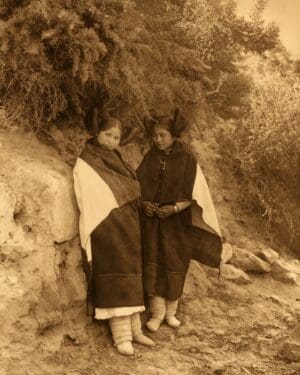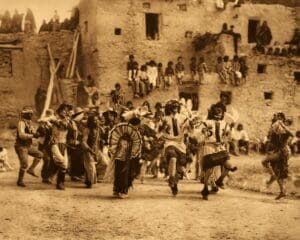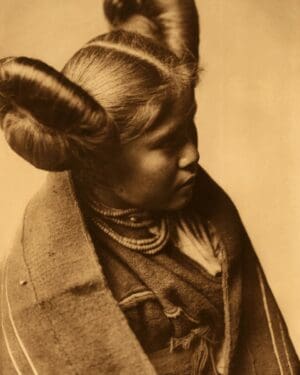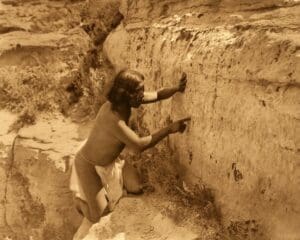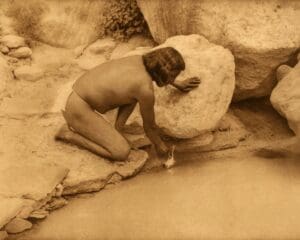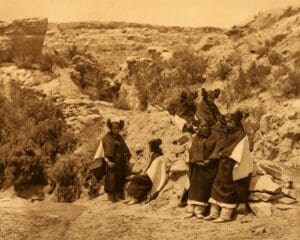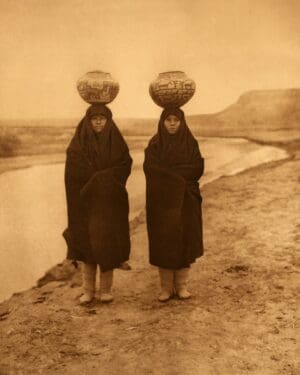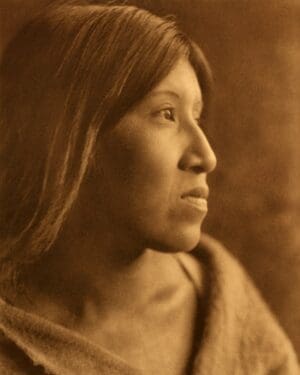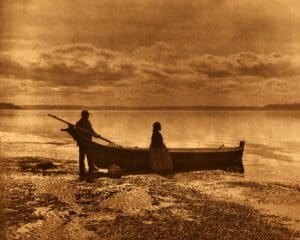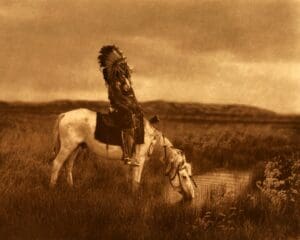Hopi Native Americans
Hopi Indian Photos by Edward S. Curtis
Tribal Summary
Dress
The primitive costume for men included a straight-sleeved or sleeveless shirt of undyed native cotton, worn like a poncho; knitted cotton leggings reaching halfway up the thighs; cotton loin-cloth; moccasins of deerskin or sandals of cleverly woven yucca-leaves; strings of turquoise beads for ear-pendants; necklaces of various berries and seeds; and a cotton head-band. Leggings were worn only in cold weather, and moccasins in snow or on a rough trail. Ordinarily only shirt and loin-cloth were used, and not uncommonly the former was discarded. In recent years Hopi men have worn calico shirts cut on the old pattern, cotton trousers extending to mid-calf, and moccasins. Commercial garments are now the rule.
Ordinarily the only garments of the primitive Hopi woman were an undyed cotton robe, which passed under the left arm and was fastened above the right shoulder, the edges overlapping at the right side, and an embroidered belt. Arms and lower legs were bare. On special occasions women wore deerskin moccasins, to which were attached white leggings of the same material, each consisting of half of a large skin, which was wrapped round and round the calf like a thick bandage. The primitive robe is never seen today at East mesa, rather frequently at Middle mesa, and quite commonly at West mesa. Calico gowns, moccasins of the Navaho type (except in ceremonies), and blue, footless, woollen stockings in the Zuni fashion are the favored costume of today.
In cold weather both sexes threw a white cotton bed-blanket about the shoulders, but men more frequently used rabbit-skin blankets, which are still commonly made by the women. The ancient style of dressing the hair still persists. Men cut it at the sides on the level of the lobe of the ear, and in front at the level of the eyes; and in the back they double it up and tie it in an elongate bunch. The head-band is worn to keep the hair clear of the eyes. Women part the hair in the middle and wear it in two thick strands about half the natural length, winding about them at the middle long, blue, cotton strings. Unmarried girls have, or used to have, the locks arranged in two large, upstanding whorls at the sides of the head. This fashion, which symbolizes the squash-blossom and indicates nominal virginity, is fast disappearing.
The Hopi have never tattooed.
Dwelling
The walls of a Hopi house are constructed of undressed stone fragments bound with mud plaster. The flat roof consists of beams resting on the tops of the walls, pole battens, rod and grass thatching, a layer of gumbo plaster, and a covering of dry earth. The floor is the native rock, if it is sufficiently level, or a gypsum-coated covering of packed earth spread over the rock, or, in the case of upper stories, over the roof of the room below. Most of the houses are more than one story in height, the maximum being four stories, and as each level is more restricted than the one below it, the result is a series of terraces. The upper apartments are reached by outside ladders, and formerly, as a safeguard against attack, ground floor rooms were accessible only through hatchways in the roof. Small openings in the outer walls admitted light and air. Except in the case of buildings constructed within comparatively recent years, it is misleading to speak of Hopi houses. The ancient structures are really apartment houses sheltering a larger number of families. From time to time new rooms were added here and there, much as a colony of bees adds the cells necessary for its increasing population, but with far less regularity.
Food
The Hopi staff of life has always been corn, which is prepared in a great variety of ways. Most important, however, is the varicolored, paper-thin bread called piki. Pikami, a slightly fermented and baked pudding, is a favorite dish. Beans and squashes were cultivated in ·primitive times, and with the coming of the Spaniards peaches, muskmelons, watermelons, and chile were added to the Hopi diet. Pinon-nuts, juniper-berries, prickly pear and yucca fruit, potherbs, and mescal secured from nomadic tribes were eaten. Rabbits offered the principal, and usually a fairly abundant, supply of meat. Antelope, deer, and mountain-sheep were hunted, and the smallest rodents, mice, rats, squirrels, and prairie dogs, were not despised. In the latter part of the eighteenth century sheep began to be of importance to the Hopi, not only for their flesh but for the wool.
Showing 1–9 of 36 results
-
Sale!
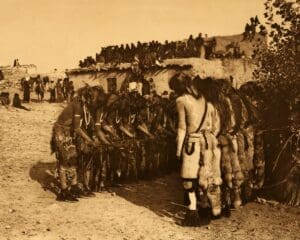
Antelopes and snakes at Oraibi
$18.95 – $120.95 -
Sale!

At the trysting place
$18.95 – $120.95 -
Sale!

Buffalo dance at Hano
$18.95 – $120.95 -
Sale!

Chaiwa – Tewa
$18.95 – $120.95 -
Sale!

Chaiwa – Tewa, profile
$18.95 – $120.95 -
Sale!

Counting the record
$18.95 – $120.95 -
Sale!

Depositing a prayer-stick
$18.95 – $120.95 -
Sale!

East mesa girls
$18.95 – $120.95 -
Sale!

East side of Walpi
$18.95 – $120.95

